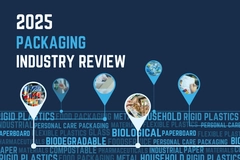Complex cleaning process regularly causes production stoppages in foil processing
05 Aug 2012

Corona treatment is a process that not only enables the production of coloured chips bags and fruit labels but is also used in the labelling of cosmetics tubes and jars, and is of extreme importance in foil processing and finishing.
Corona treatment is a process that not only enables the production of coloured chips bags and fruit labels but is also used in the labelling of cosmetics tubes and jars, and is of extreme importance in foil processing and finishing.
However, dust and dirt tends to collect inside the treatment system, which, over time, represents a hazard to the functionality of the entire plant, making regular servicing a necessity. When conducting maintenance, many corona plants only allow the removal of the internal electrode cartridge, while any dirt and dust that has collected in the machine remains there. It must then be removed by a complex combination of vacuum suction and cleaning, during which time the plant is unproductive. But now, Ahlbrandt System GmbH has developed an electrode cartridge, designed to be used with its Corona Narrow Web system, primarily for narrow foil web processing and label printing, which has a built-in dust trap and suction pipe, and which can be removed and cleaned in a matter of minutes, resulting in minimal stoppage time.
Corona treatment involves subjecting a foil web to a high-voltage electric discharge, thus rendering foils made of polyethylene, polypropylene or polyester are more receptive to bonding with inks or adhesives. The surfaces of these materials are highly water-resistant, non-polar and electrically insulating. This can be neutralised by feeding the foil over an earthed cylinder. The web passes between the cylinder and a series of electrodes, which release the electric discharge. The effect of this is to increase the surface tension by way of dispersive and polar interactive components, which make the foil receptive to the application of inks, lacquers, solvents, dyes or plastic dispersions. However, the procedure also causes dirt and dust to collect, which can be hazardous to the treatment process.
Corona treatment involves subjecting a foil web to a high-voltage electric discharge, thus rendering foils made of polyethylene, polypropylene or polyester are more receptive to bonding with inks or adhesives. The surfaces of these materials are highly water-resistant, non-polar and electrically insulating. This can be neutralised by feeding the foil over an earthed cylinder. The web passes between the cylinder and a series of electrodes, which release the electric discharge. The effect of this is to increase the surface tension by way of dispersive and polar interactive components, which make the foil receptive to the application of inks, lacquers, solvents, dyes or plastic dispersions. However, the procedure also causes dirt and dust to collect, which can be hazardous to the treatment process.
Easy-change system enables electrode replacement in seconds Although the majority of corona treatment systems on the market do contain a removable electrode cartridge, the suction pipe and dust trap remain inside the machine. This means that the often inaccessible parts must be cleaned by hand. The consequence of this is that dirt can spread through the whole plant, which adds unnecessarily to maintenance times. "The Corona Narrow Web is equipped with the 'Easy Change' system, in which the electrode cartridge, that safely encapsulates any dirt and dust, can be removed together with the suction pipe. All the dirt can simply be emptied out and the cartridge replaced," explains Dr. Alexander Rau, product manager at Ahlbrandt System GmbH. The electrodes in the cartridge can be replaced just as quickly, and require only a few turns to remove. This means that the system can be serviced in less than three minutes, and there are no extended stoppage times.
The Corona Narrow Web system produced by Ahlbrandt can be installed in narrow spaces or simply integrated into existing plants. The system is able to cope with foil widths of up to 750 millimetres, with a web speed of 500 metres per minute. But even with small outputs, the corona generated by the Ahlbrandt system is extremely homogeneous. This makes it ideal for narrow-web applications and label printing for all types of foil, from plastic to aluminium, with material thicknesses of up to 1.5 millimetres. If desired, the system can also be modified to individual requirements. Up to nine ceramic electrodes can be installed on each side, permitting both single- and double-sided treatment at extremely fast speeds. Depending on his preferences, the user can choose a treatment cylinder with either a ceramic or a stainless steel surface.
Generator with real-text display simplifies fault finding
Secure process management is guaranteed by the integrated proportional controller. This raises the output in accordance with increases in speed, which is the responsibility of the system generator. It has an output capability of up to 20kW and can be controlled via an integrated operator panel and LED display. It is able to generate 50 signals and instructions in the event of any fault, which means technicians do not have to first locate the source of the problem but can commence remedial action immediately. The display can also be set to one of several languages, making the instructions clear to all users. "All in all, the system is designed specifically to ensure that servicing times are kept to an absolute minimum," says Rau.
The Corona system for narrow-web applications was presented at the drupa on May 3-16, 2012 in Düsseldorf and is available now.
Source: Ahlbrandt System GmbH
All content and features on this website are copyrighted with all rights reserved. The full details can be found in our privacy statement
Subscribe to our newsletters
By continuing to browse our site you agree to our Privacy Statement











